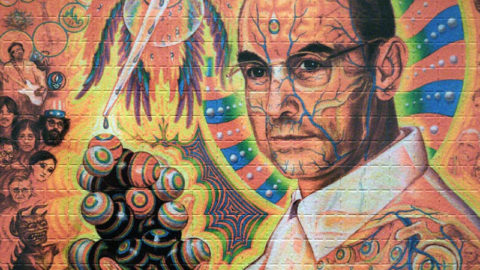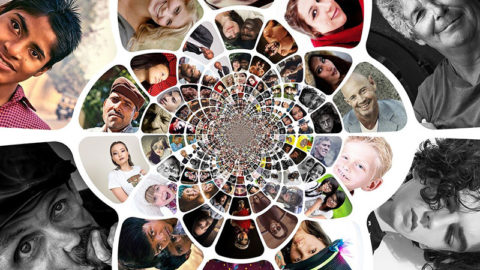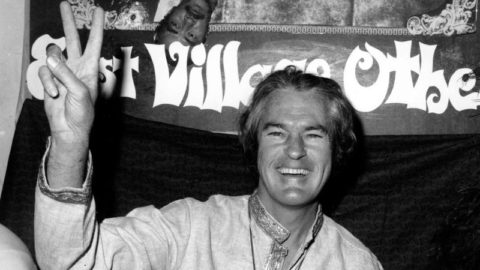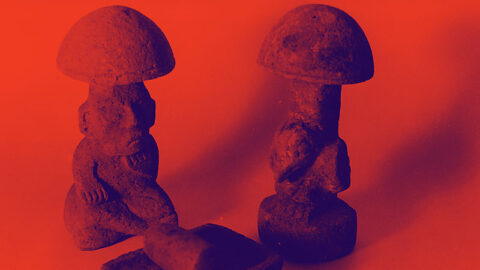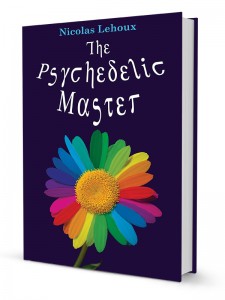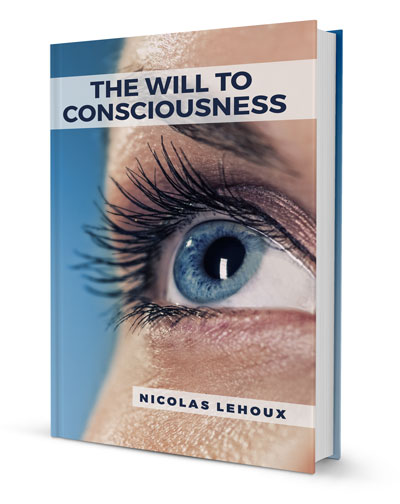Extract from The Psychedelic Master
.
Psychedelic experiences and dreams are chemical cousins; they are only different in degree.
– Terence McKenna
The word psychedelic comes from the Greek psyque and delos and means to see the psyche. Dreams are psychedelic in this sense because through them we experience our own psyche communicating holographically through multiple senses. The state of being connected to a psychedelic experience, to dreams, and to trances caused by the creative violence that inhabits me are all similar. This is a subtle state in which the invisible is omnipresent and where I feel at home. In this state of being resides the secret of my presence on this planet. I like to lie down, turn off my mind and let the vast brightly-lit spaces appear to me. This is how I receive the most valuable revelations on how to be harmonious. I plug myself into the cosmic harmony. I feel the universe in its entirety.
We must learn to reconnect the screen of our supermind, because the information we receive from it comes by way of multi-sensory and multi-dimensional holograms which are far richer and truer. Dreams, like the psychedelic experience, are a form of communication present at all times and to which we must simply be attentive. But the panopticon of the supermind is so rich that it is easy to get lost in it if we are not well anchored in our physical body. Indeed, the transcendental realms are so perfect that we may have difficulty reintegrating the human world with its suffering, set-backs, limitations and ignorance that make everything so heavy. I am happy, however, and I have a mission to anchor me here even if sometimes I get side-tracked, shaken, or feel forgotten and misunderstood. A sense of profound harmony never leaves me regardless of circumstance. I am what I set out to be. I turned off the programs which attempt to make me a robot… a random number in a factory producing absurdities. I swim against the current and I own it.
Women are intuitive. Their sensitivity means they are already listening. As a result, they tend to need the help of psychedelics less than men to activate their subtle circuits. As Florinda Donner, a student of Castaneda, wrote in her book Being-In-Dreaming, women work more directly on the level of dreams, without necessarily needing to take entheogens to draw their attention to this aspect of their being. It is rather the opposite for men, who tend to be rational, critical and often let the intellect take too much space. Since psychedelics effectively disable the mind, it is for some of us the best way to move past it and travel to deeper and nonlinear parts of our being, to transcendental realms.
Dreams became increasingly important in my life from the day I started having lucid dreams. After three months of psychedelic yoga, that is to say a high dose every week combined with daily meditation, I began to spontaneously have lucid dreams twenty-four hours after my psychedelic experience. What a joy it was to finally dream consciously! My first fantasies were quickly realized: flying, having sex, going through walls, etc. I ended up tiring of it, however, and began to wonder about the utility and relevance of experiences like lucid dreaming. In fact, I could not overcome my fantasies, as if I were an automaton without a will controlled by animal impulses and habits. I had sex and flew as much as I wanted, but I kept feeling there was something artificial about it all. So I looked for a way to disable the basic programs to advance to a level where I would have more freedom of movement and expression, and where I would not be subject to the habits of my physical and mental body.
We all have allies who work with us in the invisible, so I began searching for my guide. I traveled through my dreams asking everyone if they knew where I could find him. It was enough for me to visualize and affirm several times my desire to meet him before I fell asleep to create a thought of him in my dreams. This also often helped me become lucid. I crossed his path several times without seeing him. I finally met him as a bearded psychologist, but was not able to stay conscious long enough to chat with him. But he did have time to say: “We will have an enlightening moment together.” This meeting marked me deeply.
Lucid dreams are clearer and more conscious than the psychedelic experience and I am more relaxed and open during them. But this phenomenon was triggered as a side effect of intense psychedelic experimentation. Lucid dreams were not nearly as prevalent before. So I started reading about the subject and quickly discovered techniques to encourage them. I stopped my psychedelic experiments after four months to concentrate on the dreams that had suddenly become clearer, more present. I realized then how much dreams are psychedelic, that is to say, they make the psyche visible. This is a concrete example of the power of revelation of psychedelics.
I then went through a fertile period of lucid dreaming. I practiced techniques like those taught by Stephen Laberge, an American psycho-physiologist and leader in the scientific study of lucid dreaming. Laberge researched lucid dreaming for his doctorate in psycho-physiology at Stanford University in 1980. He devised techniques to enable himself and other researchers to induce lucid dreams. These techniques, however, left me unsatisfied because my problem was not having lucid dreams, but understanding the purpose of such experiences. In other words, he did not answer my questions: Why have lucid dreams? How do I tie these experiences in with my everyday life?
I realized then that a part of my life was lost to me because, though I wrote down my dreams, I still did not know what to do with them. So I carefully read the work of C.G. Jung for clues and learned to interpret certain symbols, though still without actively bringing myself to use and fully understand the messages. Nevertheless, this new perception of reality inspired me to reduce the frequency of my psychedelic experiences and focus on my dreams. Florinda Donner’s Being-In-Dreaming enlightened me about dreaming. Unlike Castaneda, whose initiation was rooted in psychedelics, hers took place with the help of dreaming sorceresses who dragged her into subtle adventures and showed her to what extent the boundary between dreams and waking is blurred and almost nonexistent. She developed her powers without the aid of psychedelics. This had a powerful impact on my ideas about psychedelics. I realized that using them had led me to an awareness of the importance of dreams as a rich environment for visions, significantly more relaxed and pure than the psychedelic experience, more real than the waking state. I then stopped looking at the finger pointing at the sun and focused on the sun itself.
At about the same time, I discovered Creative Dreaming by Patricia L. Garfield on the dusty shelf of a thrift shop. This book taught me how to use dreams to improve my daily life and overcome obstacles. Among other things I learned that the Senoi, a Malaysian hunter-gatherer peoples, are adept and wise in their extensive use of lucid dreaming to ensure their happiness and mental health. For them, “Dreamer” does not carry the pejorative weight it does for Westerners. Quite the opposite, it expresses the ability to interact with dreams, know how to behave in them and share them with the tribe – in short, to use them for the good of the community. Following a daily meeting to exchange dreams of the previous night, the tribe elders make decisions based on the dreams’ messages and meanings to guide the day’s activities. In their community, dreamers are aware of the importance of their nocturnal visions and the beneficial impact they can have on their daily lives, when they know how to use them. In this case, the art of dreaming, passed down from generation to generation, helped make the Senoi a peaceful community, happy and free. When encountering an enemy in a dream, for instance, tradition suggests to kill him and ask him for a power gift. I experienced this a few times and it was amazing.
Garfield’s book also discusses the dream techniques of Tibetans who are able to meditate consciously in their sleep. This piqued my curiosity to say the least, and I turned again to the East for answers. I found them in Tenzin Wangyal Rinpoche’s The Tibetan Yogas of Dream and Sleep, in which he presents a dream meditation technique. I obtained mind-blowing results, including several experiences of white light, and finally I realized that dreams are a form of preparation for the process of death… and life. By dreaming consciously, I increase my chances of forming a permanent center of gravity in myself which enables me to voluntarily stay conscious during the dying process. For waking up in the morning and forgetting our dreams is to forget our divine nature. In sum, an individual must stay voluntarily conscious in his dreams if he wants to be immortal.
It is beneficial to know how to use dreams to improve our daily lives. I recently discovered the Dream Maker technique created by Dr. Richard Corrière and Dr. Joseph Hart. Their book, The Dream Makers, suggests a method that abandons traditional dream interpretation in favor of a pragmatic practice that focuses on the role, expression, feelings and clarity of the dreamer. They arrive at the conclusion that the interpretation of dreams is an endless process which always leads to more interpretation. They then develop a technique that allows anybody to make their dreams work in their favor and juxtapose them with their waking state. This technique stimulates the occurrence of “breakthrough dreams,” which juxtapose everyday life with dream life, to the point where the difference between the two states evaporates as they collide and trigger a state of dazzling clarity. The dream is then stripped of its symbols and becomes clear, intelligible and straightforward – interpretation is no longer required because instead we receive a proposed action or feeling. If I notice I am being too passive, for example, I can increase my participation in my waking life, and the same for my expression, my feelings and my clarity. I have already seen the effectiveness of this dreaming practice. My dreams now form a delicate likeness juxtaposed with my daily life: by being attentive to it, I have been able to solve situations to which I had found no rational solution. I also found my partner this way. The day before we met, I had this dream: I am in my kitchen and think about the new woman I want to meet. My former girlfriend is there, capturing my thoughts, and she says, “I can pay you a whore, at any price.” I got up and said that what I expected was for her to do the same for me as I had done for her, that is, introduce me to a woman who could also be her friend. Then I let her go and sat back down. I knew intuitively that I had had a breakthrough dream, because the encounter was so real. I shared my dream with my former girlfriend explaining that she was psychically blocking access to my new companion. She predicted to me that within twenty-four hours I would meet my new girlfriend, and indeed I did.
The example above is a concrete instance of a dream clearly showing me how to act, what to say and what to think about a situation. It showed me the path to take to get out of an impasse. I saw clearly and acted without hesitation, operating the miracle without concession. This is how the Senoi consider their dreams, and this is why they are so attentive to them, discuss them and follow them concretely during the day.
The psyche has its own agenda; it is objective and detached from the vicissitudes of mundane life. But it also intuitively intervenes to inform the ego if it is not being attentive or harmonious. The less a person pays attention to his feelings and his intuitions, the more aggressive and upsetting dreams will become. Nightmares indicate a lack of communication between the nocturnal and diurnal life, between the person and his being. We would be well served to be taught from childhood how to make dreams work for us instead of forgetting them and relegating them to the realm of pure fantasy, but it is not the case. If being called a dreamer in our society is pejorative, it says a lot about our outlook on dreams. Yet it is undeniable that those who rise in the morning to a cacophonous alarm lose out on the best of their lives. For it is in the morning that we have the most revealing dreams and are in the best position to be aware of them and remember them.
.
Extract from The Psychedelic Master




